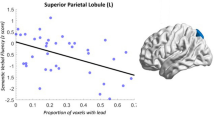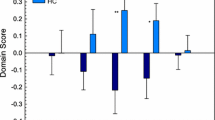Abstract
Introduction
The aim of this study was to analyze brain functional connectivity and its relationship to cognition in patients with mild traumatic brain injury (mTBI).
Methods
Twenty-five patients with mTBI and 25 healthy control subjects were studied using resting-state functional MRI (rs-fMRI). Amplitudes of low-frequency fluctuations (ALFFs) and functional connectivity (FC) were calculated and correlated with cognition.
Results
Compared with the normal control group, the mTBI patients showed a significant decrease in working memory index (WMI) and processing speed index (PSI), as well as significantly decreased ALFFs in the cingulate gyrus, the middle frontal gyrus and superior frontal gyrus. In contrast, the mTBI patients’ ALFFs in the left middle occipital gyrus, the left precuneus, and lingual gyrus increased. Additionally, FC significantly decreased in the thalamus, caudate nucleus, and right hippocampus in the mTBI patients. Statistical analysis further showed a significant positive correlation between the ALFF in the cingulate gyrus and the WMI (R 2 = 0.423, P < 0.05) and a significant positive correlation between the FC in the left thalamus and left middle frontal gyrus and the WMI (R 2 = 0.381, P < 0.05).
Conclusion
rs-fMRI can reveal the functional state of the brain in patients with mTBI. This finding differed from observations of the normal control group and was significantly associated with clinical cognitive dysfunction. Therefore, rs-fMRI offers an objective imaging modality for treatment planning and prognosis assessment in patients with mTBI.




Similar content being viewed by others
References
Langlois JA, Rutland-Brown W, Wald MM (2006) The epidemiology and impact of traumatic brain injury: a brief overview. J Head Trauma Rehabil 21:375–378
Belanger HG, Vanderploeg RD, Curtiss G, Warden DL (2007) Recent neuroimaging techniques in mild traumatic brain injury. J Neuropsychiatry Clin Neurosci 19:5–20
Nolin P, Heroux L (2006) Relations among sociodemographic, neurologic, clinical, and neuropsychologic variables, and vocational status following mild traumatic brain injury: a follow-up study. J Head Trauma Rehabil 21:514–526
Whitnall L, McMillan TM, Murray GD, Teasdale GM (2006) Disability in young people and adults after head injury: 5–7 year follow up of a prospective cohort study. J Neurol Neurosurg Psychiatry 77:640–645
Scheid R, Walther K, Guthke T, Preul C, von Cramon DY (2006) Cognitive sequelae of diffuse axonal injury. Arch Neurol 63:418–424
Draper K, Ponsford J (2008) Cognitive functioning ten years following traumatic brain injury and rehabilitation. Neuropsychology 22:618–625
Biswal B, Yetkin FZ, Haughton VM, Hyde JS (1995) Functional connectivity in the motor cortex of resting human brain using echo-planar MRI. Magn Reson Med 34:537–541
Iraji A, Benson RR, Welch RD et al (2015) Resting state functional connectivity in mild traumatic brain injury at the acute stage: independent component and seed-based analyses. J Neurotrauma 32:1031–1045
Stevens MC, Lovejoy D, Kim J, Oakes H, Kureshi I, Witt ST (2012) Multiple resting state network functional connectivity abnormalities in mild traumatic brain injury. Brain Imaging Behav 6:293–318
Johnson B, Zhang K, Gay M et al (2012) Alteration of brain default network in subacute phase of injury in concussed individuals: resting state fMRI study. Neuroimage 59:511–518
Mayer AR, Mannell MV, Ling J, Gasparovic C, Yeo RA (2011) Functional connectivity in mild traumatic brain injury. Hum Brain Mapp 32:1825–1835
Raichle ME, MacLeod AM, Snyder AZ, Powers WJ, Gusnard DA, Shulman GL (2001) A default mode of brain function. Proc Natl Acad Sci U S A 98:676–682
Zang YF, He Y, Zhu CZ et al (2007) Altered baseline brain activity in children with ADHD revealed by resting-state functional mri. Brain Dev 29:83–91
Hoptman MJ, X-NZ BPD (2010) Amplitude of low-frequency oscillations in schizophrenia: a resting state fMRI study. Schizophr Res 117:13–20
Salvador R, Suckling J, Coleman MR, Pickard JD, Menon D, Bullmore E (2005) Neurophysiological architecture of functional magnetic resonance images of human brain. Cereb Cortex 15:1332–1342
Liu Y, Liang M, Zhou Y et al (2008) Disrupted small-world networks in schizophrenia. Brain 131:945–961
Folstein MF, Folstein SE, McHugh PR (1975) Mini-mental state. A practical method for grading the cognitive state of patients for the clinician. J Psychiatr Res 12:189–198
Chao-Gan Y, Yu-Feng Z (2010) DPARSF: a MATLAB toolbox for “pipeline” data analysis of resting-state fMRI. Front Syst Neurosci 4:13
Pelled G, Goelman G (2004) Different physiological MRI noise between cortical layers. Magn Reson Med 52:913–916
Yin Y, Li L, Jin C et al (2011) Abnormal baseline brain activity in posttraumatic stress disorder: a resting-state functional magnetic resonance imaging study. Neurosci Lett 498:185–189
Fornito A, Zalesky A, Bullmore ET (2010) Network scaling effects in graph analytic studies of human resting-state FMRI data. Front Syst Neurosci 4:22
Wang J, Wang L, Zang Y et al (2009) Parcellation-dependent small-world brain functional networks: a resting-state fMRI study. Hum Brain Mapp 30:1511–1523
Wang JH, Zuo XN, Gohel S, Milham MP, Biswal BB, He Y (2011) Graph theoretical analysis of functional brain networks: test-retest evaluation on short- and long-term resting-state functional MRI data. PLoS One 6:e21976
Tang L, Ge Y, Sodickson DK et al (2011) Thalamic resting-state functional networks: disruption in patients with mild traumatic brain injury. Radiology 260:831–840
Niogi SN, Mukherjee P, Ghajar J et al (2008) Structural dissociation of attentional control and memory in adults with and without mild traumatic brain injury. Brain 131:3209–3221
Salmond CH, Menon DK, Chatfield DA et al (2006) Diffusion tensor imaging in chronic head injury survivors: correlations with learning and memory indices. Neuroimage 29:117–124
Yonelinas AP, Hopfinger JB, Buonocore MH, Kroll NE, Baynes K (2001) Hippocampal, parahippocampal and occipital-temporal contributions to associative and item recognition memory: an fMRI study. Neuroreport 12:359–363
Wig GS, Schlaggar BL, Petersen SE (2011) Concepts and principles in the analysis of brain networks. Ann N Y Acad Sci 1224:126–146
Zalesky A, Fornito A, Harding IH et al (2010) Whole-brain anatomical networks: does the choice of nodes matter? Neuroimage 50:970–983
Hayasaka S, Laurienti PJ (2010) Comparison of characteristics between region-and voxel-based network analyses in resting-state fMRI data. Neuroimage 50:499–508
van den Heuvel MP, Stam CJ, Boersma M, Hulshoff Pol HE (2008) Small-world and scale-free organization of voxel-based resting-state functional connectivity in the human brain. Neuroimage 43:528–539
Acknowledgments
This study was funded by the General Program of National Natural Science Foundation of China (81171866,81571889), the Starting Fund of Overseas Returnees of Ministry of Education (2012) and the National Basic Key Research Program (973) (2014CB541602).
Author information
Authors and Affiliations
Corresponding author
Ethics declarations
We declare that all human and animal studies have been approved by the Third Military Medical University Ethics Committee and have therefore been performed in accordance with the ethical standards laid down in the 1964 Declaration of Helsinki and its later amendments. We declare that all patients gave informed consent prior to inclusion in this study.
Conflict of interest
We declare that we have no conflict of interest.
Rights and permissions
About this article
Cite this article
Xiong, K., Zhang, J., Zhang, Y. et al. Brain functional connectivity and cognition in mild traumatic brain injury. Neuroradiology 58, 733–739 (2016). https://doi.org/10.1007/s00234-016-1675-0
Received:
Accepted:
Published:
Issue Date:
DOI: https://doi.org/10.1007/s00234-016-1675-0




